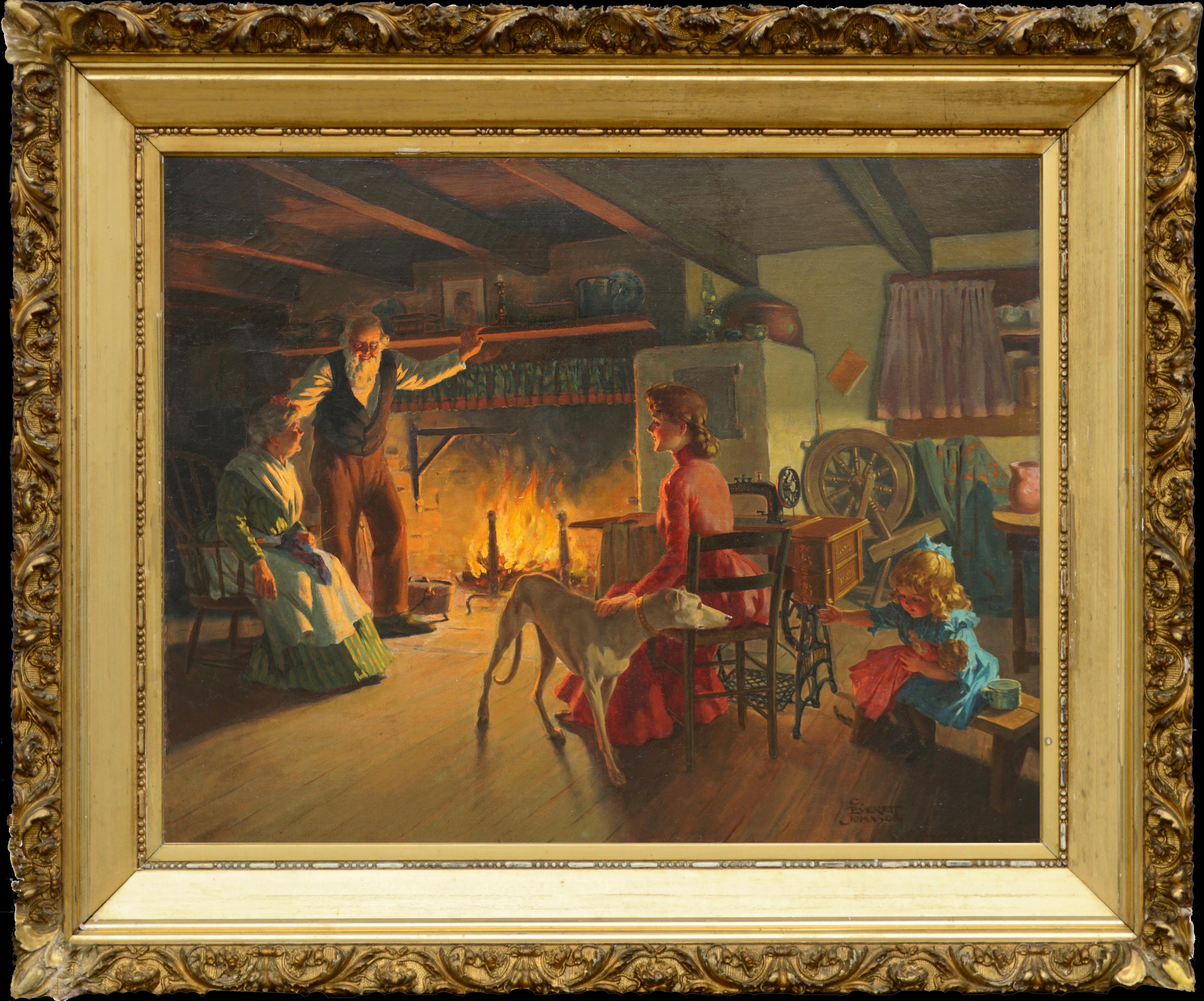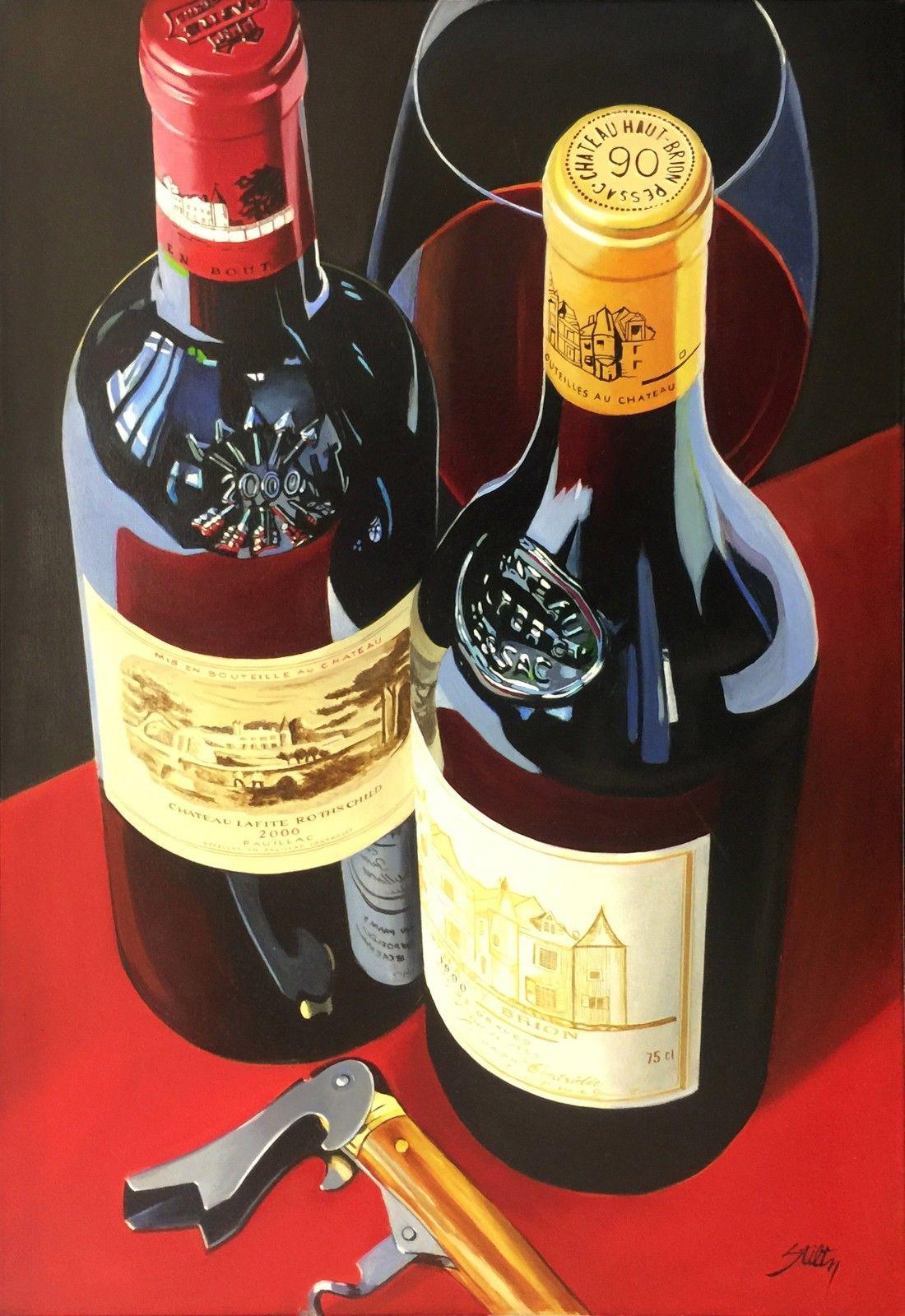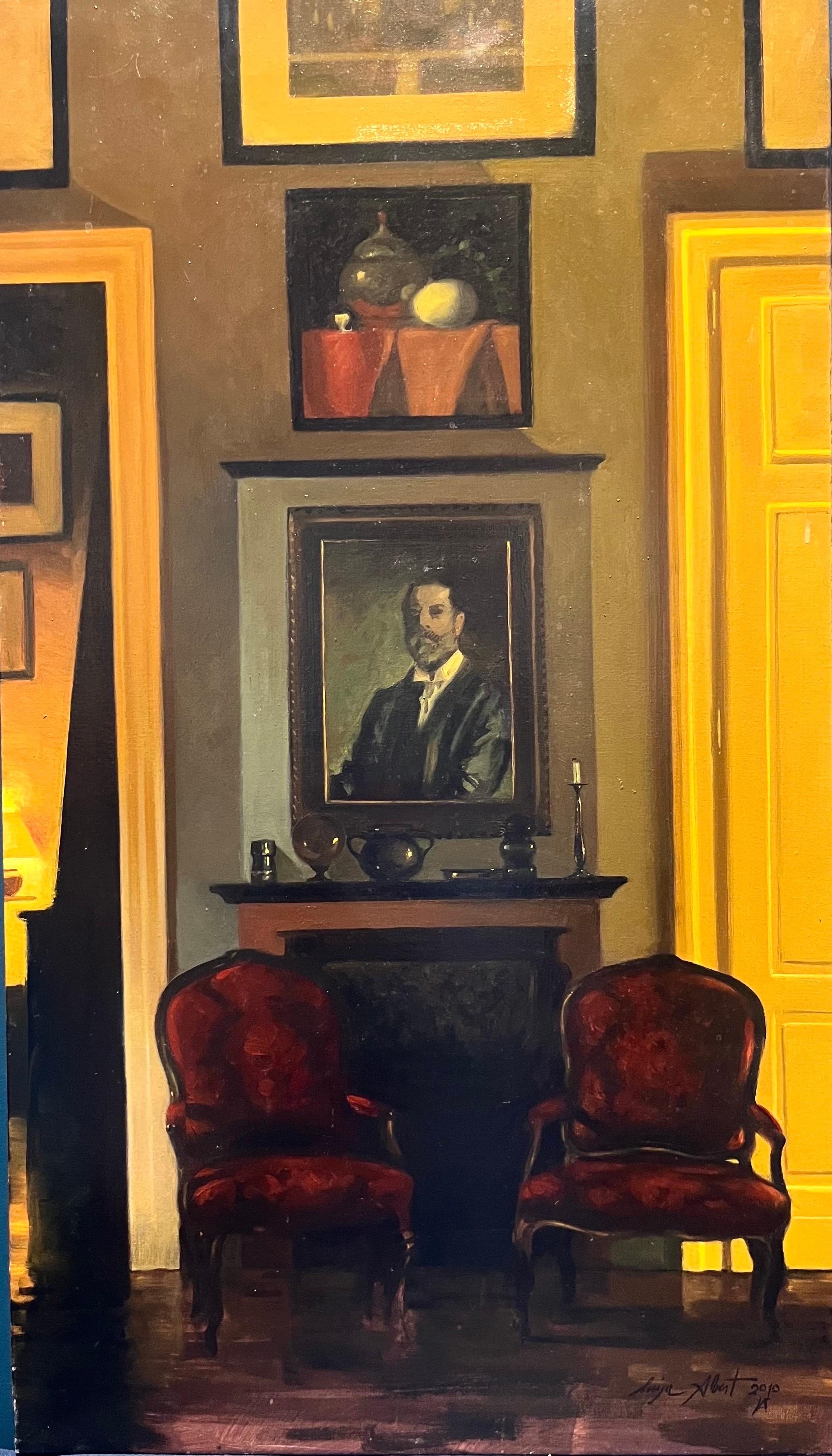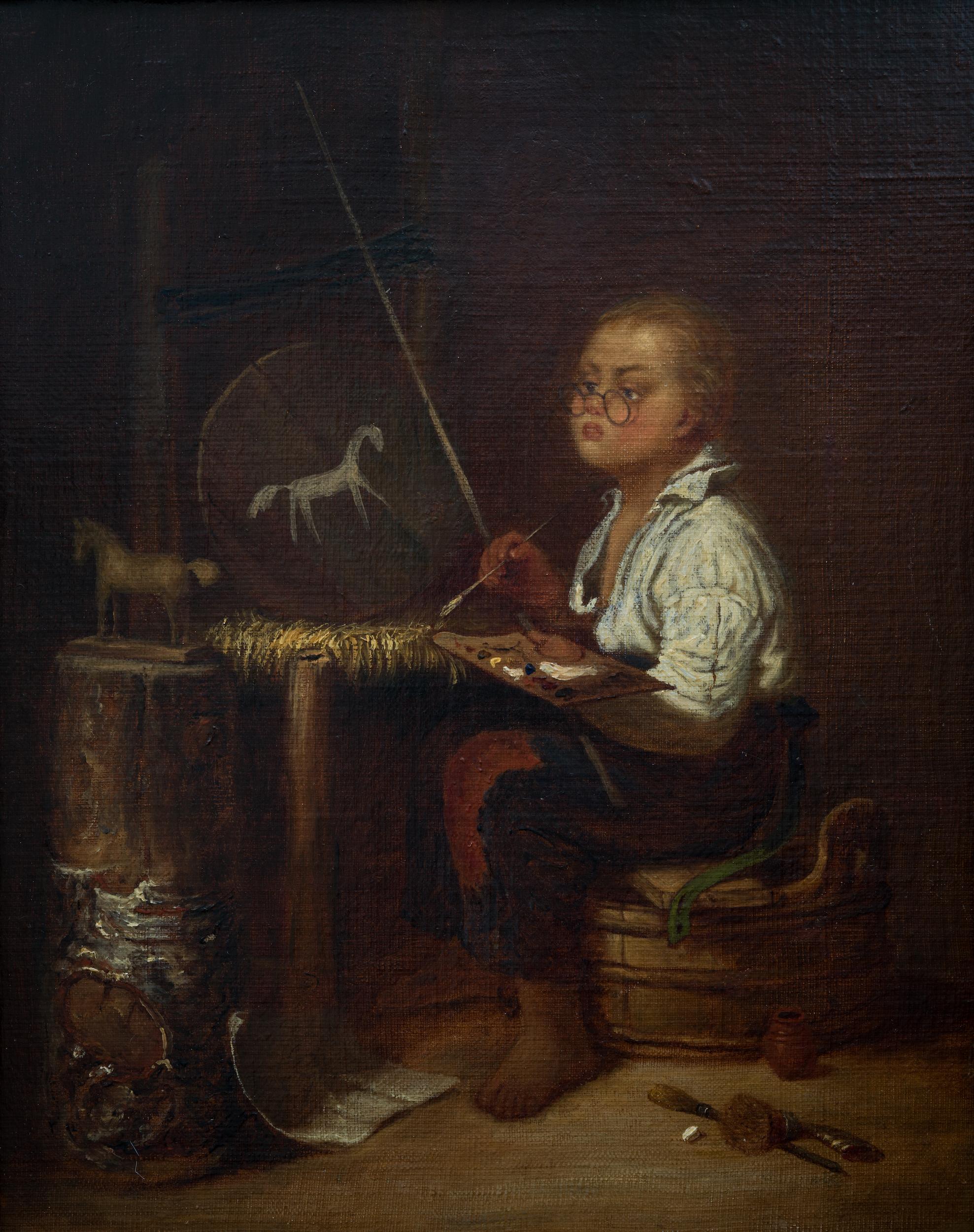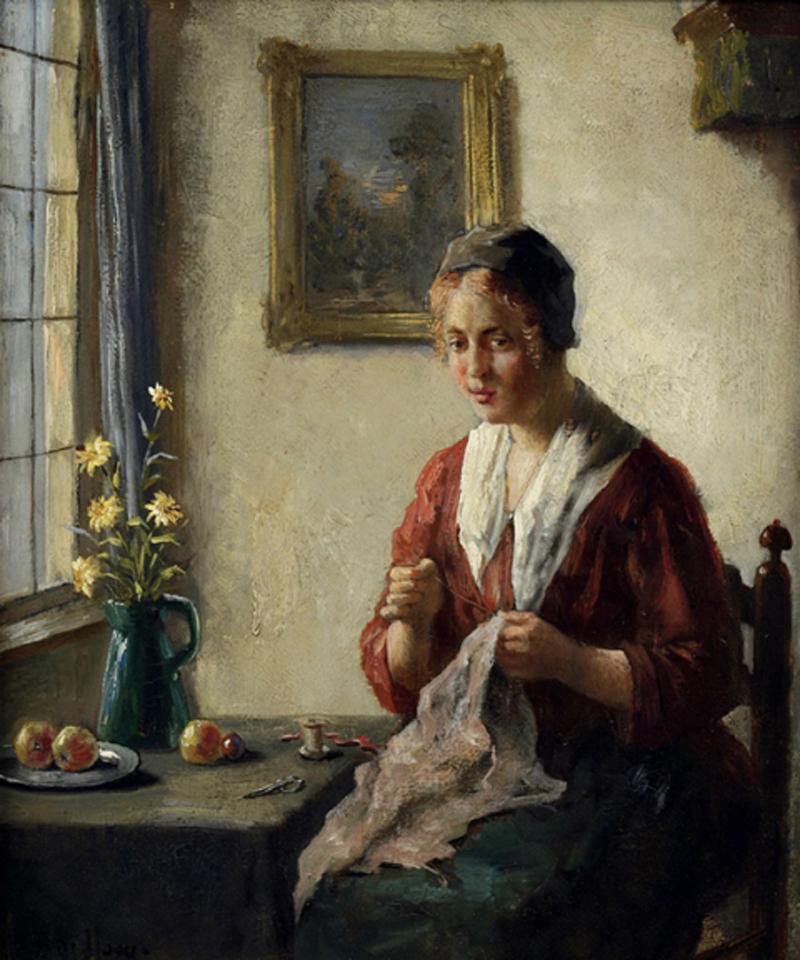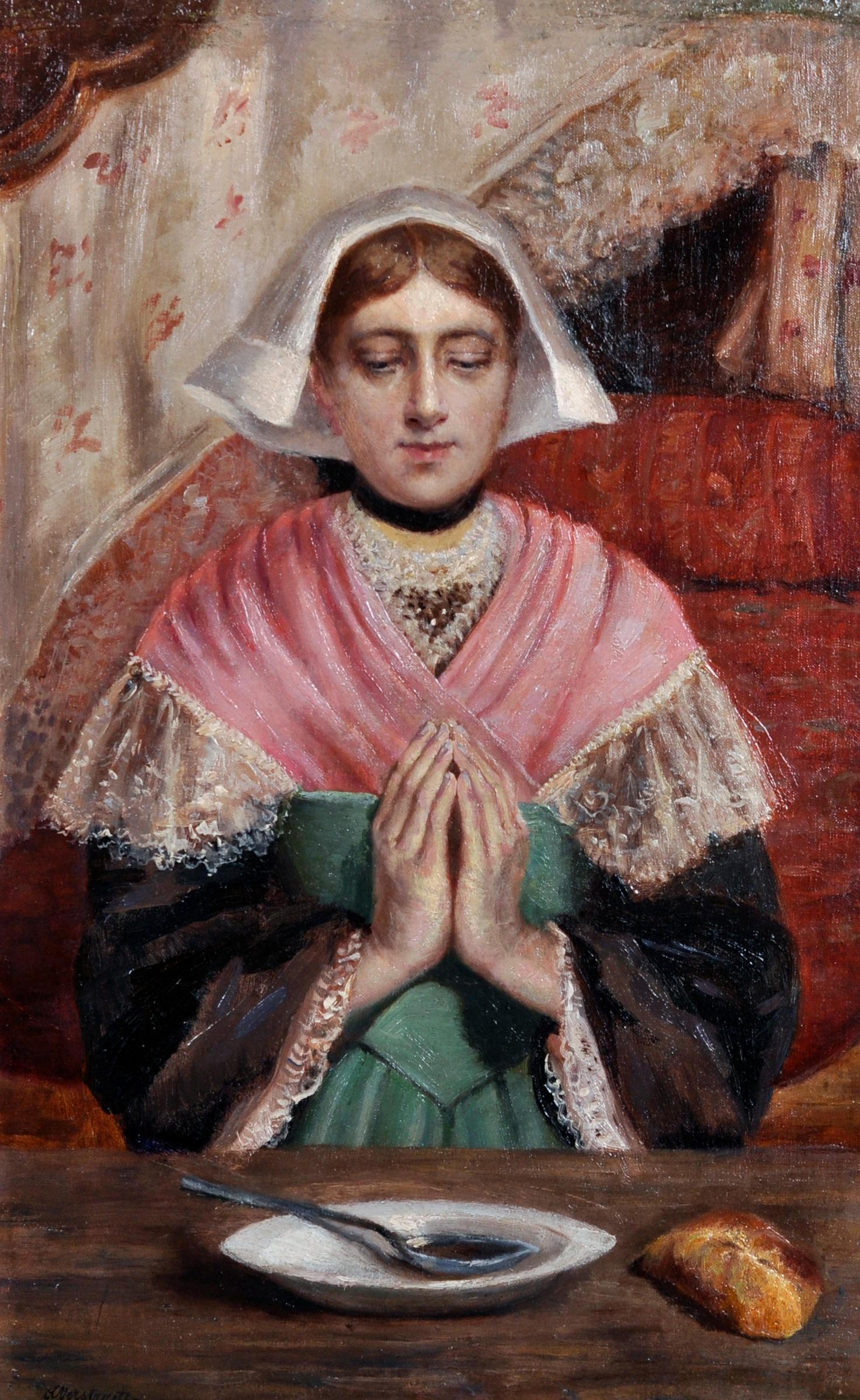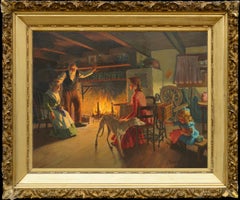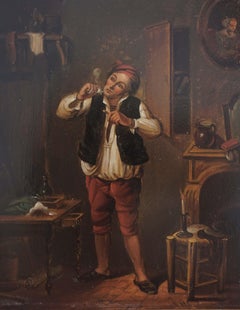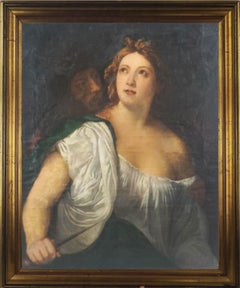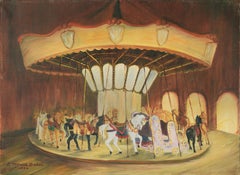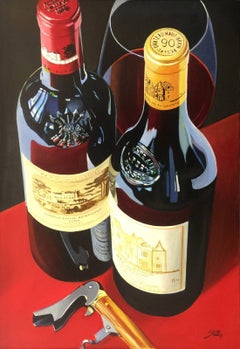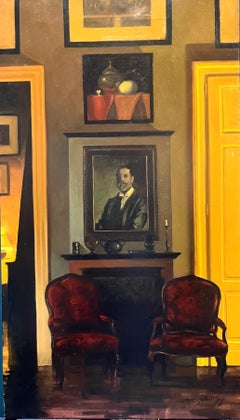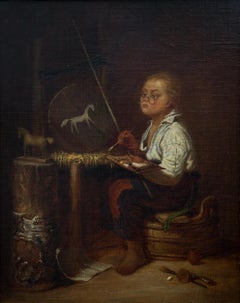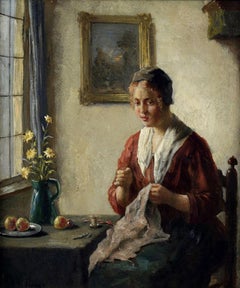Items Similar to A Jolly Time -- German Genre Tavern Painting, 1918
Want more images or videos?
Request additional images or videos from the seller
1 of 10
Karl Josef MullerA Jolly Time -- German Genre Tavern Painting, 19181918
1918
About the Item
Wonderful German genre painting of 17th century tavern scene in style of Franz Hals by Karl Josef Muller (German, 1864-1942) dated 1918. Signed and dated lower left corner "Karl Muller - Hamburg 1918". Condition: Good; professionally restored: Canvas restreched on new stretcher bars; five repairs made to small tears in canvas (see image); cleaned and re-varnished with UV-resistant varnish. Unframed. Image size: 39.5"H x 55"W. We have the original frame which needs some extensive repair to the gesso. Happy to include the frame with the painting as is.
Karl Müller was born in Hamburg-Altstadt in 1865. His wealthy Jewish parents Abraham Müller (1832-1896), citizen of the Hanseatic city since 1869, and Henriette "Jette", b. Burchard (born 1832 Neubuckow / Mecklenburg), had a cigar factory at Spielbudenplatz 5 in St.Pauli. When Karl Müller was ten years old, next to factory and warehouse, now at Speersort 11 (Altstadt), there was also a branch in Altona-Ottensen with the address Am Felde 68. The family lived at the time at Pferdemarkt 13 (Old Town).
After attending the Jewish Foundation School at the Zeughausmarkt, Karl Müller completed a three-year lithography apprenticeship. From 1886 to 1888, he studied at the Royal Saxon School of Applied Arts in Dresden with the history and decoration painter Donadini, then with Professor Hanke of the Prussian Academy of Arts in Berlin.
Karl Müller's painting style was conventional-realistic and did not follow modern trends. In 1891, the oil paintings "Preparation for the Service", "In the guardroom", tattoo", "gymnastics lesson", "covert patrol” and "return from the field service exercise”, whose main motive almost always soldiers formed.In 1893, he painted the" invasion of the 76er " as a horizontal format in black and white, the painting was acquired by the Museum of Hamburg History in 1930. The disposition of Karl Müller could be classified as "kaisertreu" and "national" (Maike Bruhns) at this time - not by chance he acted with his Nicknamed "Soldatenmüller", he successfully participated in exhibitions in Berlin and Hamburg before the turn of the century.
Even at this time, the frequent change of residence is striking: 1893 Papendamm 25 (Rotherbaum), 1896 Bundesstraße 9 (Rotherbaum). In 1898 he was in the Hamburg address book as a "genre and portrait painter" with the residential address 1. average 43 (Rotherbaum) out.
At the age of 38, Karl married in 1903 in the Hanseatic city of the Jewish Louise Hauer (born 12.2.1872 in Hamburg), called "Lieschen". Before her marriage, she lived with her mother at Grindelberg 78. Her father, Martin Hauer (1836-1897), also born in Hamburg and was a citizen of the city since 1862, owned a factory for soap and perfume. In 1904 and 1911, the two daughters Karla and Lotte were born.
1904, the family lived at this time in the Bogenstraße 20, Karl Müller commissioned a portrait of the emigrated hamburger Henry Jones opening the same lodge in the Hartungstraße 9-11. Already at this time he might have been a member of the Hamburg Artists Association of 1832.
Starting from 1908 further change of dwellings on the basis of the telephone books are comprehensible: nearly yearly the family moved and moved thereby from the Grindel quarter over Hoheluft east to Harvestehude and Winterhude. Around 1912 she moved into an apartment in Sierichstraße 156. Here, the landlord Schröder provided the artist with an area of around 45 square meters as a studio on the dry floor. But the building police criticized this use and after some disputes, the painter had to move once again with family and studio. The official telephone directory recorded as an address from 1914 to 1918 Klosterallee 20 (Harvestehude).
Friedrich Jansa described Karl Müller's changed motif choice in his artist's glossary in 1912: "In recent years he has been watercolouring a lot in the Hamburg area and now mainly takes his motifs from Hamburg harbor life." All of his works are privately owned. " Landscapes, portraits, harbor scenes and folk life were created. Karl Müller did not participate in World War I for reasons of age.
After 1918, the public's interest in Müller's soldier paintings disappeared. The art dealer Karl Heumann recalled in 1951 in a letter to the daughter, which was forwarded to the Office for Reparation: "I met your father shortly after the First World War, when I was managing director of the Kunstsalon Krone There were also a number of pictures of him in and out of the shop, which, as I recall, were only soldiers' pictures, maneuvers, bivouacs, etc., which I first saw here, but with the lost war, too the preference for such pictures away. "
In 1919, the naturalistic image "Old Drivers" or "Lotsenzimmer", which the Museum of Hamburg History acquired in 1964, was created.
From July 1919 to 1932 the family of four lived according to a telephone directory in Bieberstraße 9, I. Stock (Rotherbaum). By the inflation of 1923 she lost her savings. The financial situation worsened after the 1929 economic crisis. For the years 1929 to 1933, no payments were noted in the column of Karl Müller's Kultussteuerkartei card of the Jewish community. Relatives supported the family, which since 1933 lived in very limited economic conditions. The younger unmarried daughter Lotte was dismissed in 1933 at the Berlin State Theater for "racial" reasons.
The Reichskulturkammer, founded by law in September 1933, with its seven individual chambers, was a compulsory organization for artists, but made the membership dependent on an "Aryan proof". The non-membership meant de facto a professional and publishing ban for the artist. Nevertheless, published in its evening edition of January 6, 1934, the "Hamburger Fremdenblatt" a page with soldier paintings by Karl Müller, whose popular military presentation now again corresponded to the taste of the time. However, it had escaped the notice that the painter was not allowed to publish for "racial" reasons.
In the short term, Karl and Louise Müller moved into a flat in Schwenckestraße 54 III (Eimsbüttel). From 1933 to 1937 a telephone connection for the Cäcilienstraße 6 parterre (Winterhude) with the reference "painter" was registered. In order to obtain suitable premises for painting, Karl Müller built a simple wooden shed in the backyard in the summer of 1933, the roof of which reached below the windowsill of Müller's ground floor apartment. Since Karl Müller was a welfare recipient and had almost no own income left, he was granted the due approval fee of 10 RM. In October 1937, the couple moved to Gryphiusstraße 7 in Winterhude. Now Karl Müller got involved in the Jewish Culture Federation Hamburg. The last place of residence in Hamburg was an apartment in the Martin-Brunn-Stift at Frickestraße 24 in Eppendorf, which had to fulfill the function of a "deportation collective" as a "Judenhaus".
The art dealer Heumann later told the Reparations Office that he had visited Karl Muller on Frickestrasse "after receiving a letter from him asking me to assist him in sending a large number of studies and pictures abroad At that time (and now there is again) there was a law according to which paintings, which would mean an irreplaceable loss to German national artistic property, could not be readily exported, whether Jewish or Aryan property After so many years of remembering that he wanted to send the pictures to Japan, I suspect that the freight forwarder has probably pointed out this legal provision to him, and as far as I can remember I have written to him confirmation that there are no reservations about the export of his pictures (...) I do not know if the expedition of the pictures abroad is done (...) ".
The couple Müller was deported on July 15, 1942 from Frickestraße 24 with "Transport VI / 1" to the ghetto Theresienstadt. There they arrived on July 19, 1942. Karl Müller died according to the death report in the "Central Hospital Rooms 9" on 20 October 1942 to "heart failure".The artist's encyclopaedia Rump states that he starved in Theresienstadt.
Louise Rebecca Müller was deported on May 15, 1944 from the ghetto Theresienstadt to the extermination camp Auschwitz, her exact date of death is unknown. For the calculation of the indemnity claims was set by the court of May 8, 1945 as the date of death.
- Creator:Karl Josef Muller (1864 - 1942)
- Creation Year:1918
- Dimensions:Height: 39.5 in (100.33 cm)Width: 55 in (139.7 cm)Depth: 1 in (2.54 cm)
- Medium:
- Movement & Style:
- Period:
- Framing:Framing Options Available
- Condition:Professionally restored: five repairs made to small tears in canvas (see image); cleaned and varnished with UV-resistant varnish.
- Gallery Location:Soquel, CA
- Reference Number:Seller: JT-D61131stDibs: LU5427189032
About the Seller
5.0
Platinum Seller
Premium sellers with a 4.7+ rating and 24-hour response times
Established in 1986
1stDibs seller since 2014
2,877 sales on 1stDibs
Typical response time: <1 hour
- ShippingRetrieving quote...Shipping from: Soquel, CA
- Return Policy
Authenticity Guarantee
In the unlikely event there’s an issue with an item’s authenticity, contact us within 1 year for a full refund. DetailsMoney-Back Guarantee
If your item is not as described, is damaged in transit, or does not arrive, contact us within 7 days for a full refund. Details24-Hour Cancellation
You have a 24-hour grace period in which to reconsider your purchase, with no questions asked.Vetted Professional Sellers
Our world-class sellers must adhere to strict standards for service and quality, maintaining the integrity of our listings.Price-Match Guarantee
If you find that a seller listed the same item for a lower price elsewhere, we’ll match it.Trusted Global Delivery
Our best-in-class carrier network provides specialized shipping options worldwide, including custom delivery.More From This Seller
View All"The Family Hearth" - Turn of the Century Cozy Interior Figurative Scene
By Charles Everett Johnson
Located in Soquel, CA
Charming turn-of-20th Century interior painting that takes the viewer back to simpler times with grandmother, grandfather, mother sewing and a young girl playing with her greyhound a...
Category
Early 1900s Realist Interior Paintings
Materials
Linen, Oil
17th Century Genre Painting -- The Pipe Smoker
By Flemish School, 17th Century
Located in Soquel, CA
Wonderful genre painting from 18th Century of pipe smoker. Signed lower right edge with monogram "I I E". Oil paint on copper. Condition: good: minor wear/rubbing from frame's rabbet...
Category
Mid-17th Century Realist Figurative Paintings
Materials
Copper
Early 19th Century Study of Titian's "Lucretia and her Husband Lucius"
Located in Soquel, CA
Copy after Titian's Renaissance Painting "Lucretia and Her Husband Lucius Tarquinius Collatinus"
Robert Azensky Fine art is pleased to offer this copy after Titian's Renaissance mas...
Category
19th Century Italian School Figurative Paintings
Materials
Oil, Stretcher Bars, Linen
White Horse Carousel, 1956 - Original Oil Painting On Linen
Located in Soquel, CA
White Horse Carousel, 1956 - Oil On Canvas
Oil painting of an empty carousel ride, a single white horse gleams in the center. Three doorways are seen to the right, with sunlight ema...
Category
1950s American Impressionist Figurative Paintings
Materials
Oil, Linen
$520 Sale Price
20% Off
Portrait of a Woman After Gustav Klimt
Located in Soquel, CA
Portrait of a Woman After Gustav Klimt
Finely detail oil on linen of a serene young woman stylized after Gustav Klimt by Valentin Skribins (Russian/F...
Category
Early 2000s Impressionist Figurative Paintings
Materials
Linen, Oil
$1,320 Sale Price
20% Off
Portrait of a Man in Armchair, Mid Century Short Story Illustration
Located in Soquel, CA
Excellent figurative oil painting of a man seated in an armchair with papers strewn about the interior space by Charles Ross Kinghan (American, 18...
Category
1930s American Impressionist Figurative Paintings
Materials
Oil, Linen
$2,120 Sale Price
20% Off
You May Also Like
FIRST CLASS PAIR
By Thomas Stiltz
Located in Aventura, FL
Original oil on canvas. Hand signed on front by the artist. Framed. Canvas size 36 x 24 in. Artwork is in excellent condition. Certificate of authenticity included. All reasonable ...
Category
Late 20th Century Realist Interior Paintings
Materials
Canvas, Oil
$3,375 Sale Price
25% Off
"Interior with portrait of a painter" Homage to J.S. Sargent Oil cm. 40 x 70
By Luisa Albert
Located in Torino, IT
Interior ,Yellow,Italian living room,
Luisa Albert was born in Turin, Italy where she currently lives and works.
In 1989 she enrolled at the Istituto Europeo di Design in Milan and around that time she began working for publishing houses as an illustrator.
In 1992 she graduated with a degree in Illustration.
She began to study painting with Ottavio Mazzonis...
Category
2010s Realist Interior Paintings
Materials
Canvas, Oil
Oil Painting Called "The Young Artist" by Swedish Johan Christoffer Boklund
Located in Stockholm, SE
Introducing a captivating oil painting by Johan Christoffer Boklund (1817-1880). The artwork depicts a young boy practicing his painting skills. Seated beside him is a wooden horse t...
Category
19th Century Realist Interior Paintings
Materials
Canvas, Oil, Board
"Meditation" Dutch Woman Sewing Interior Genre Home scene Fruit Flowers on Table
By Bernard De Hoog
Located in Rancho Santa Fe, CA
Bernard de Hoog was born in Amsterdam in 1866. He studied under J.F. Hulk and J.C. van Essen at the Quellinus School in Amsterdam. Mainly a genre and portrait painter, he occupies a distinguished place among the masters of Dutch modernism. He was associated with The Hague School, primarily a movement of realism, a reaction against Romanticism. He lived and worked in Laren, Haarlem, Bussum, and The Hague enjoying much commercial success. His paintings were readily exported to the United State, Canada, and England.
De Hoog advocated the simple country life and produced many endearing interior scenes inspired by compassion for the impoverished existence of the Dutch peasantry. Set within a quiet domestic interior space, our painting catches a meditative moment of a woman in the midst of her sewing. A large window illuminates this intimate interior. de Hoog’s delicate brushwork captures the sunlight reflected in the woman’s red dress...
Category
Late 19th Century Realist Figurative Paintings
Materials
Canvas, Oil
19th Century Belgian Realist Oil Painting - Young Lady Saying Grace at Supper
Located in Cirencester, Gloucestershire
Artist/ School: Alfred Verstraeten (1858-1936) Belgian, signed
Title: Giving Thanks
Medium: oil painting, on canvas, unframed.
Size: painting: 21.5”...
Category
Late 19th Century Realist Figurative Paintings
Materials
Oil, Canvas
The Dueling Partners 1850's French Oil, Chateau Staircase Interior Beautiful oil
Located in Cirencester, Gloucestershire
The Duel
by Alcide Joseph LORENTZ (French 1813-1891)
signed and dated 1857
oil painting on canvas, framed
framed size: 30 x 25 inches
condition: very good and presentable, previous r...
Category
Mid-19th Century Realist Figurative Paintings
Materials
Oil, Canvas
Recently Viewed
View AllMore Ways To Browse
Modern Antique Interior
German Military Painting
Interior Old Book
Royal Art Lodge
Antique Military Painting
Antique Shop Interiors
1903 Germany
De Muller
Prussian Painting
Art Since 1945 Book
Martin Summers Painting
Cigar Painting
Jewish Genre
Tavern Scene Painting
Antique German Linens
Franz Josef
Field Telephone
Muller Oil Painting
